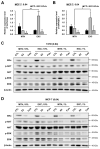A New Culture Model for Enhancing Estrogen Responsiveness in HR+ Breast Cancer Cells through Medium Replacement: Presumed Involvement of Autocrine Factors in Estrogen Resistance
- PMID: 37298425
- PMCID: PMC10253977
- DOI: 10.3390/ijms24119474
A New Culture Model for Enhancing Estrogen Responsiveness in HR+ Breast Cancer Cells through Medium Replacement: Presumed Involvement of Autocrine Factors in Estrogen Resistance
Abstract
Hormone receptor-positive breast cancer (HR+ BC) cells depend on estrogen and its receptor, ER. Due to this dependence, endocrine therapy (ET) such as aromatase inhibitor (AI) treatment is now possible. However, ET resistance (ET-R) occurs frequently and is a priority in HR+ BC research. The effects of estrogen have typically been determined under a special culture condition, i.e., phenol red-free media supplemented with dextran-coated charcoal-stripped fetal bovine serum (CS-FBS). However, CS-FBS has some limitations, such as not being fully defined or ordinary. Therefore, we attempted to find new experimental conditions and related mechanisms to improve cellular estrogen responsiveness based on the standard culture medium supplemented with normal FBS and phenol red. The hypothesis of pleiotropic estrogen effects led to the discovery that T47D cells respond well to estrogen under low cell density and medium replacement. These conditions made ET less effective there. The fact that several BC cell culture supernatants reversed these findings implies that housekeeping autocrine factors regulate estrogen and ET responsiveness. Results reproduced in T47D subclone and MCF-7 cells highlight that these phenomena are general among HR+ BC cells. Our findings offer not only new insights into ET-R but also a new experimental model for future ET-R studies.
Keywords: aromatase inhibitor; autocrine factor; breast cancer; endocrine therapy; estrogen; medium replacement; resistance; responsiveness.
Conflict of interest statement
The authors declare no conflict of interest.
Figures







References
MeSH terms
Substances
Grants and funding
LinkOut - more resources
Full Text Sources
Medical
Research Materials

